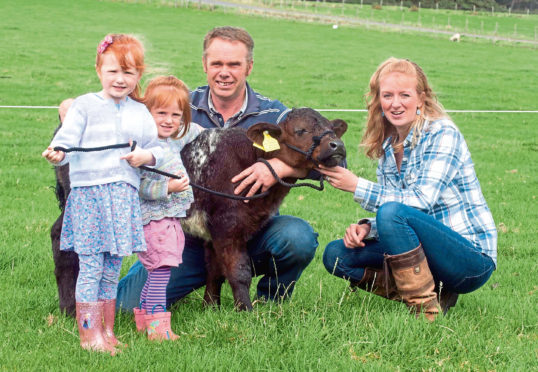It’s been described as the Rolls-Royce of beef, with its succulent, fat-marbled steaks commanding as much as £600/kg in the world’s fanciest restaurants.
Now Wagyu beef, which was once only reared in Kobe, Japan, is coming to a plate near you, thanks to an intrepid bunch of Scottish beef farmers who are embracing the breed – and aiming to make Scotland Europe’s Wagyu beef capital in the process.
Often called Kobe beef, there are tales about the pampered lives Wagyu cattle enjoy, from daily massages which help make the meat tender, to enjoying a daily pint of lager to help create a rich flavour.
Thankfully for the farmers who’ve decided to bring these unusual cattle to Scotland, most of these are myths.
“The only beer that’s drunk around here is drunk by me,” laughs Andrew Anderson, of Smallburn Farms near Elgin.
Keen to offer customers at family-run Allarburn farm shop a premium product, he introduced three Wagyu females and a Wagyu bull into his 700-head suckler herd five years ago.
Since then he has been breeding around 30 Wagyu-Continental cross cattle a year for discerning customers who can’t get enough of his steaks, burgers and Wagyu pies – the latter of which were shortlisted in a national food competition this month.
“We like to give customers something different, and once you experience eating Wagyu you’re reluctant to go back,” he says.
“It’s incredibly tender thanks to the marbling, and it tastes delicious. We have some customers who travel a long way to buy our steaks.”
The reaction to the beef does, Andrew admits, make up for some of the challenges which come with raising the animals.
“They are a lot slower to mature, and the lack of weight gain means they wouldn’t work for commercial production,” he says.
“We put the Wagyu bull to the heifers, which means we get a small, easy-calving offspring that still gives us good marbling, but we get that larger carcass through being a cross.
“Because they are kept for so long I graze them on grass and try to keep them outside as long as possible. It just cuts down on your end value otherwise.”
The cost means that having a final market for produce is critical, he says.
“Unless we had a market to pay to it doesn’t pay – you couldn’t just go an buy a Wagyu bull and expect to make money. We know where 100% of our meat is going, and having that system in place is what makes it work for us.”
Promoting the quality of Wagyu beef directly to customers is something Martine Chapman of Highland Wagyu in Dunblane, the UK’s largest producer of Wagyu cattle, has certainly capitalised on.
She and husband Mohsin Altajir started breeding Wagyu for their own dining table seven years ago, but quickly expanded to 900 animals after demand for their produce spread.
Today they sell Wagyu beef to a host of top restaurants and celebrity chefs, send their meat to customers as far away as Hong Kong, and have ambitious plans to expand their herd up to 5,000 cattle – making Scotland the Wagyu centre of Europe in the process.
Martine, who moved to Moshin’s family farm from London with no experience of working in agriculture, says: “It started as a hobby but it quickly escalated to a full-scale business. I think the stockman thought I was completely crazy when he saw the animals, as they don’t even look like beef cattle, but the reaction we have had has been incredible.”
Genetics plays a huge part of Martine and Mohsin’s business, and while the couple also breed pedigree Aberdeen-Angus, Beef Shorthorn, Highland and Dexter cattle, their main focus is on producing full-blood Wagyu.
Their aim has always been to produce meat with a consistent marbling score of 9+ – the highest rating outside Japan – ensuring they are offering a luxury product to a discerning market.
Martine says: “It’s a wonderful product, and once I starting knocking on doors and showing chefs what we could produce and the interest just grew.
“It’s a small world when you are dealing with chefs, so thanks to word of mouth we started linking up with more and more restaurants and it’s gone on from there. We have created a luxury brand that people want a taste of.
“It was a struggle at the beginning, but now it’s booming.
“In the last year or two it’s really grown in popularity. I think it’s just the beginning for Wagyu production in the UK.”
